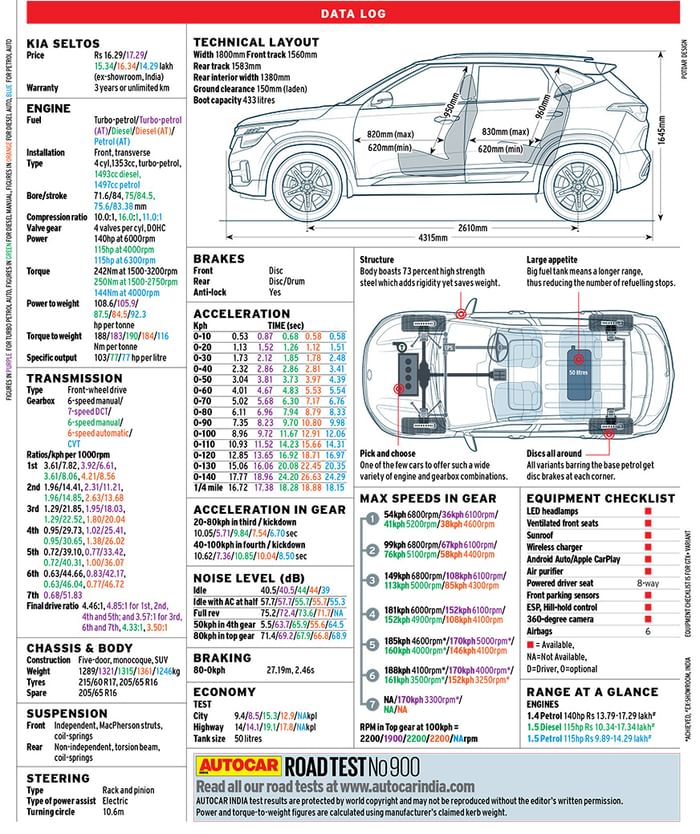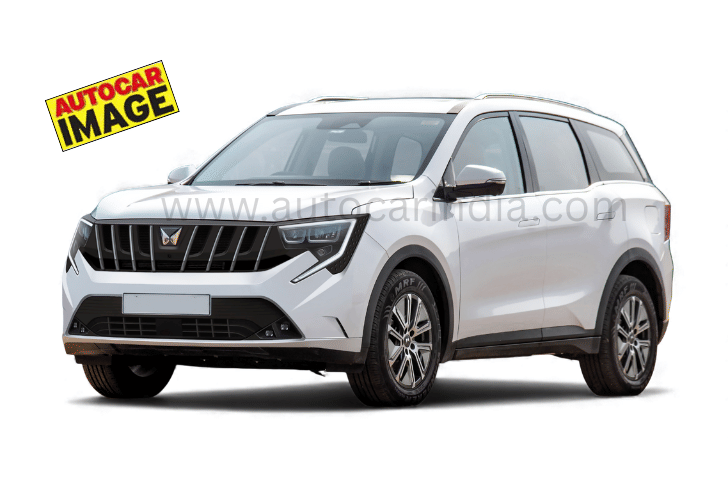Kia made a grand debut in India by carpetbombing the midsize SUV segment with its first offering – the Seltos. This is an SUV that comes with a wide variety of engine and transmission options, an expansive list of features and, with prices ranging between Rs 9.89 lakh and Rs 17.34 lakh (ex-showroom, Delhi), it covers a wide range of price points. With a choice of three engines, four transmissions and multiple trim levels, the Seltos caters to a wide spectrum of customers, and it’s no surprise that, in just a few months, it emerged as the bestselling SUV in the country. But just how deserving is it of the customer’s trust? We put both the petrol and diesel variants through an exhaustive road test to see how good it is in the real world.
Based on an all-new platform, the 4,315mm-long Seltos fits smack in the middle of the midsize SUV segment and strikes a good balance of being not too small and not too big. It feels a class up on cars like the Duster and Kicks, and isn’t as big as the Tata Harrier, MG Hector and Mahindra XUV500. In fact, as a 5-seater, it’s got the right proportions, offers a strong stance, and yet is compact enough for the city commute.
The Seltos’ body structure boasts 73 percent high-strength steel, which adds the necessary rigidity, yet saves weight. For its size and the amount of equipment packed in, it’s a fairly light SUV.
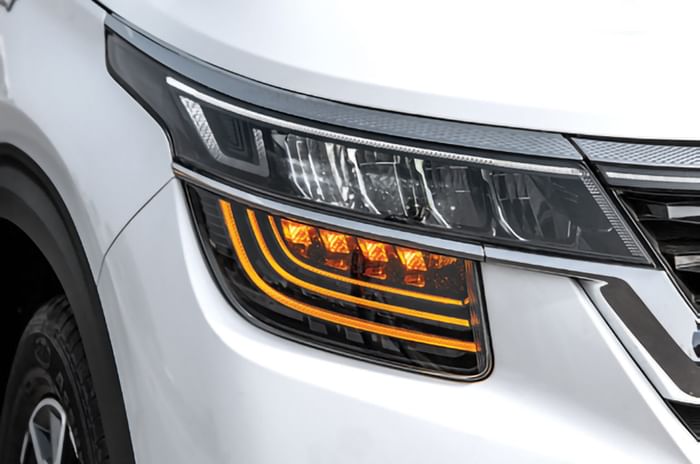
What the Seltos establishes is Kia’s family look and the Korean brand’s signature ‘Tiger Nose’ grille with tasteful chrome detailing that grabs your attention. The sweptback LED headlamps and vertically stacked fog lamps stand out, as do the red accents on the GT Line variant. The 17-inch alloy wheels fill the wheel arches nicely, while the high bonnet, upright stance, downward-sloping roofline, and rising window line give it a sophisticated appearance. At the rear, the LED tail-lamps and chrome tailgate applique make the Seltos easily identifiable even from afar.
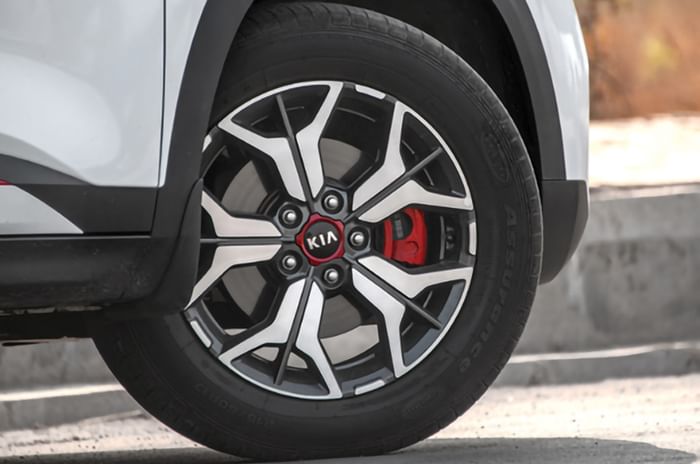
Overall, its styling isn’t as conservative as the Duster’s or the Creta’s; it looks fresh and wears a rather contemporary design language.
Kia has done a great job when it comes to offering a high-quality, upmarket feel in the cabin. All the touchpoints have a soft, premium feel – be it the door pads, or the flat-bottom steering, the dashboard fascia or the gear lever, everything feels great to touch. The matte silver and piano black finishes, coupled with the two-tone dashboard colour, look upmarket, and the fit-finish of all the panels and switchgear is top-notch. While it is easy to get swayed by its overall quality, the dashboard design will polarise opinions, due to the large rectangular bezel that stretches from the instrument cluster dials and surrounds the touchscreen, mimicking modern Mercedes’ dashboard design.

The Seltos’ large door cavities, flat floor sill, and upright cabin make ingress and egress a breeze. The front seats are comfy, and supportive, and the cushioning too is well judged. Finding the right driving position is easy, thanks to the seat and steering adjustments on offer, and the well laid-out controls.
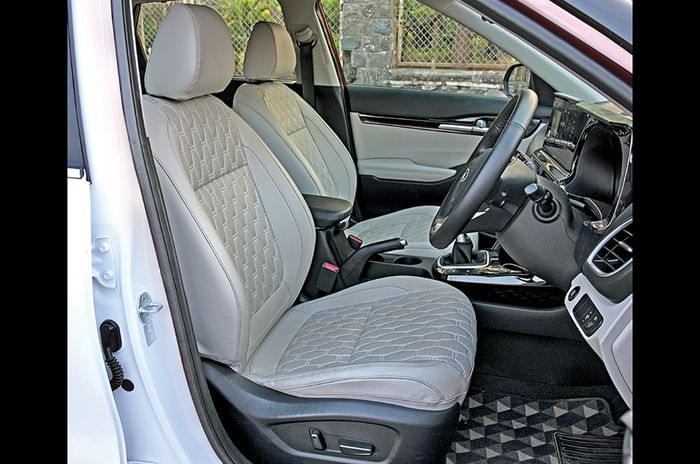
The driving position is nice and upright; so most owners will enjoy the fact that the bonnet lies in their field of vision. Visibility is good, and what helps further are the driver aids like front parking sensors, 360-degree camera, as well as the lane-changing camera that displays a live video feed on the MID each time the indicator is flicked, thus eliminating blind spots. Storage areas are cleverly designed too, with wide door bins, cupholders, and smaller spaces for knick-knacks.
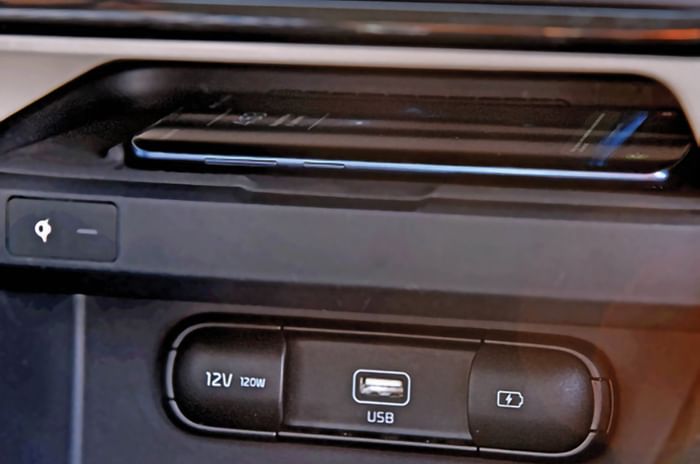
But it isn’t all perfect. The wireless charging pad, though a big plus, is not the easiest to access and large phones have to be wiggled into place. Taller drivers would find thigh support to be a bit inadequate, the driver armrest isn’t adjustable, the volume controls will be a bit of a stretch for the front passenger, window controls aren’t backlit, and then the working of the head-up-display – although a novelty in this segment – isn’t very well executed, so most would prefer to keep it tucked out of sight. Also, the air-con doesn’t adjust airflow easily and even the positioning of the vents is not optimal for the driver.

Rear-seat occupants will find legroom to be decent, with the bench being quite comfy for a car this size. Of course, it doesn’t have the same amount of space as the Harrier or the Hector, and the seats could do with a bit more underthigh support. However, the almost flat floor, and a reasonably wide seat mean a third passenger won’t feel unwelcome here. What’s nice is that the backrest also reclines to a very comfy angle (up to six degrees), although the controls for it are inconveniently positioned on top of the backrest, rather than beside the seat. The large window area and the rear quarter gives the cabin an airy feel, and sliding back the sunroof (only available on the GTX+ and HTX+ trims) further brightens up the space. At 433 litres, the Seltos’ boot is very usable. It is wide and has a flat loading lip, making it easy to load heavier cargo.

The Seltos is offered under a HT (Tech) Line and a GT Line, with four variants each. The range comprises three engines which get two transmission options each, and 13 colour schemes (including five dualtone options). All variants get basic kit like dual airbags, ABS with EBD, parking sensors, four disc brakes (base 1.5-litre petrol has only front), projector headlamps, Bluetooth audio system, steering controls, rear AC vents, driver-side armrest and remote key entry.

The 1.5-litre petrol is available only in the higher mid-spec HTX (Tech Line) which comes with features like auto LED headlamps, a 10.25-inch touchscreen with Android and Apple connectivity, UVO connected apps, auto-dimming inside mirror, climate control, cruise control, air purifier, 17-inch alloys, electric folding mirrors, camera, and rear wiper and washer. The top-spec diesel-manual is the HTX Plus that adds a Bose sound system, a sunroof, ventilated seats, wireless charging and some more features. However, despite its price of Rs 15.34 lakh (ex-showroom, India), it misses out on side and curtain airbags, as well as ESP.
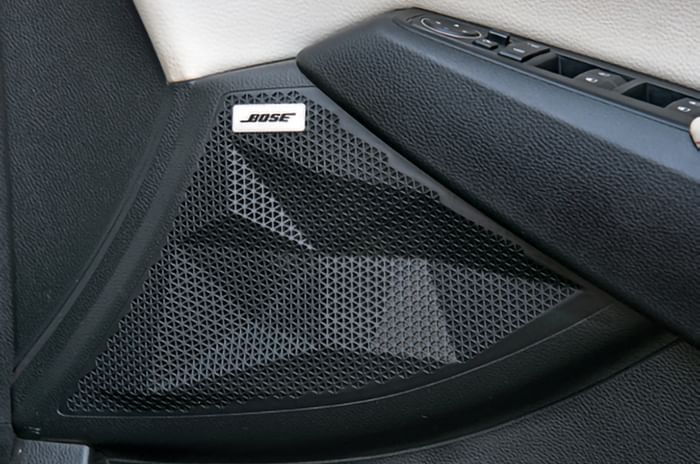
The 1.4-litre turbo-petrol manual and automatic are available only in the GT Line which is the sportier of the two trim lines. The top-spec GTX plus is available with the turbo-petrol manual and automatic, and diesel automatic. Over the top-spec diesel manual, it gets six airbags, ESP, a heads-up display, rain-sensing wipers; the automatics also get multidriving modes and traction control.
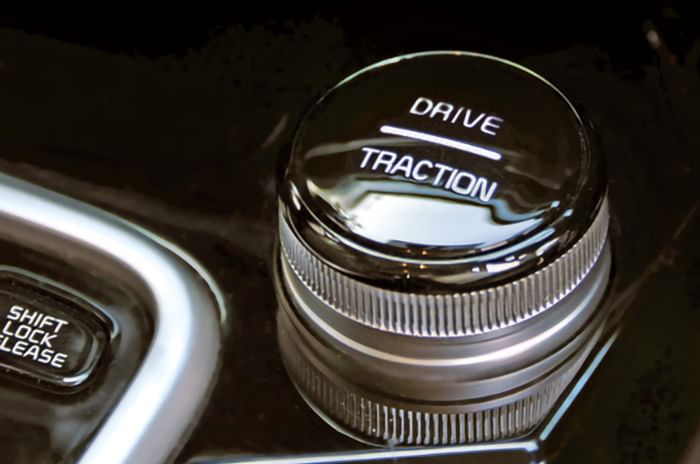
By offering multiple options to buyers, Kia has created one of the most confusing variant mixes in recent times.
Kia’s 10.25-inch touchscreen is easy to read but it’s not the best in terms of response or touch-sensitivity. Earlier batches had a software glitch where the screen would suddenly go blank, but this problem has now been solved. You get the option of two to three split displays, and that proves to be useful during navigation. Improving usability further are the touch-operable shortcut controls beneath the screen.
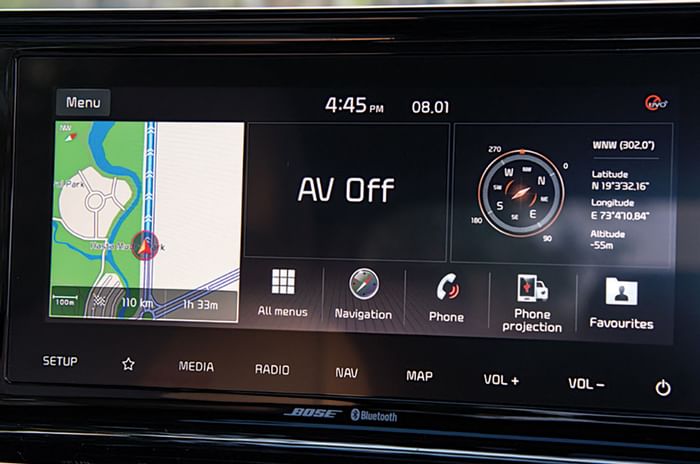
While most users will be happy using Android Auto and Apple CarPlay, higher variants also get the SIM-based UVO connected tech, which offer roadside assistance and concierge services at the press of a button placed on the inside mirror.
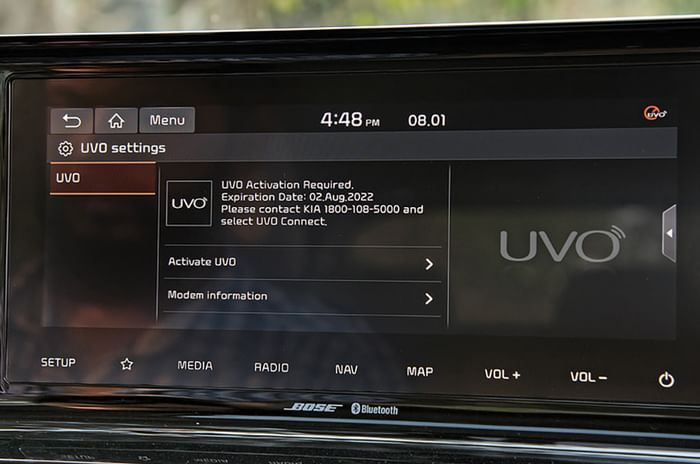
Kia is offering buyers a choice of three different engines – a 115hp, 1.5-litre naturally aspirated petrol; a 140hp, 1.4-litre turbo-petrol; and a 115hp, 1.5-litre diesel engine. Each of these get a 6-speed manual and an automatic option as well. What’s unique is that each automatic transmission is exclusive to each powertrain. The 1.5-litre petrol gets a CVT (continuously variable transmission), the 1.4-litre turbopetrol gets a 7-speed DCT (dualclutch transmission), and the diesel gets 6-speed torque converter automatic. Kia has taken the lead in its segment by introducing BS6-compliant engines – for which the catalytic converters in the petrols have received some tweaks, but changes to the diesel are more significant like the addition of a highpressure pump, a catalytic converter with a diesel particulate filter (DPF), and a lean NOx trap (LNT).
With power and torque figures of 140hp and 242Nm, respectively, the 1.4-litre turbo-petrol motor surely impresses on paper, and even more so in the real world. Refinement levels are top-notch, and even on the move it goes about doing its job in a silent manner. Those with a keen ear will hear a faint whistle-like sound from the intake past 2,000rpm when the engine is under load. Beyond 5,000rpm, the engine sounds a bit boomy. Throttle responses are sharp, and because max torque comes in from as low as 1,500rpm, there’s no perceptible delay in performance. Spin it past 2,200rpm and the tachometer needle swings towards the redline in a rather enthusiastic manner. While performance in the mid-range is strong, there’s no prominent spike in power delivery, so it builds speed in a very linear manner. Hold on to a gear longer and it will spin past 5,000rpm in a gutsy manner, although power begins to taper off beyond 6,000rpm. The 6-speed manual’s gearing is very tall, so it will rev until 6,800rpm in the first three gears, with the first maxing out at 54kph, second at 99kph, and third at 149kph. The tall gearing and impressive torque spread shoots the Seltos from 0-100kph in a rapid 8.9sec, making it the quickest sprinter in India under Rs 20 lakh. Acceleration through the gears is equally impressive, despite the taller ratios. The manual transmission is a delight to use, with slick shifts that provide a reassuring click each time the gear slots into its gate. The clutch, although light, has a long travel, and the pedal feel isn’t consistent, so you’ll need to modulate it carefully to drive smoothly.
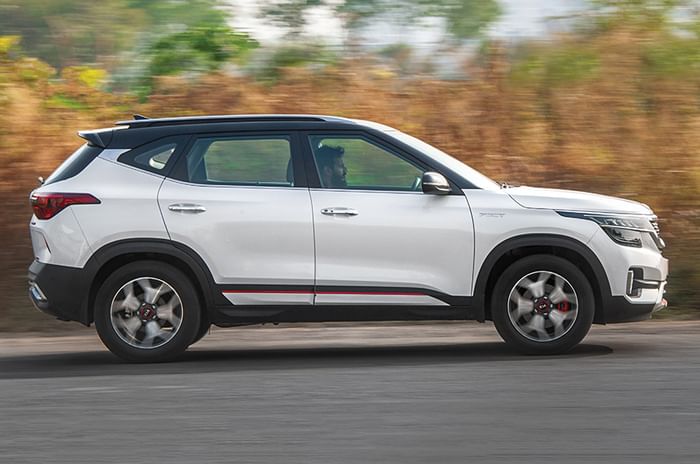
Paired to the turbo-petrol is also a 7-speed dual-clutch automatic transmission. This unit is fairly quick like most twin-clutch units and is almost always in the right gear. There are driving modes too, and in ‘Normal’ and ‘Eco’, it shifts to the highest gear possible at the earliest; for example, it shifts to sixth gear by 60kph and seventh by 80kph. Within urban confines, there’s barely any difference between the two modes; so the Eco mode feels very usable, and it doesn’t blunt performance or responsiveness either. However, it does reduce the effectiveness of the air conditioning, and this can be uncomfortable on a hot day. The third driving mode is ‘Sport’, which sharpens throttle responses, weights up the steering and programmes the transmission to hold onto gears longer. But what it does is also aggravate the snappy engagement of the DCT which isn’t very userfriendly in start-stop traffic. In fact, one of the weaknesses of the Seltos’ DCT is that clutch engages a bit too sharply and it doesn’t have a progressive feel. Backing into a parking spot in reverse can be tricky because of this sudden engagement. It’s also important to point out that the Seltos DCT did face overheating issues because of excessive clutch ‘slip’ in stop-start traffic. A new software update has reduced the slip but the clutch now engages more like an on-off switch, making it feel a touch too snappy. Paddleshifters would have enhanced the drive experience but the Tiptronic mode does offer the option to change gears manually. The Seltos DCT has a few rough edges and is clearly not as smooth or refined as Volkswagen’s DSG unit, which, in terms of shift quality, is still the benchmark.
The Kia Seltos’ 1.5-litre diesel sets a new benchmark in its segment in terms of refinement and drivability. The motor is extremely smooth and the diesel clatter or drone is well in check. What’s nice is that power delivery is linear, and just like the turbo-petrol, this diesel makes its max torque of 250Nm right from 1,500rpm, so lag is minimal. Lazy drivers will be happy to drive around town in higher gears without the need to downshift often; it can easily exit a speed breaker in second gear, without any juddering. The real meat of the powerband is between 2,200rpm and 4,000rpm, making it a great cruiser; overtaking in this range feels effortless. While the bottom-end and mid-range are rather impressive, it does run out of breath towards its top-end; so even though the engine will spin until about 5,000rpm, it begins to sound clattery and rather coarse beyond 4,000rpm, with barely any energy left in the last 1,000rpm. The 6-speed manual, just like the turbo-petrol’s unit, has a very positive shift action, and although its clutch requires a bit more effort than the turbo-petrol’s, the pedal feel is far more linear and easier to judge. Being down on power compared tothe Creta 1.6-litre diesel-manual results in a slower 0-100kph time of 11.67sec, (Creta’s is 10.81sec), but the Kia simply blows away the Creta when it comes to drivability – 20-80kph in third gear is 1.58sec faster, and 40-100kph in fourth gear is 1.57sec faster, reflecting on how much more drivable the Seltos is compared to the Hyundai.
The 6-speed torque converter automatic is smooth and performs seamlessly while cruising. Demand for quicker responses, however, and it is slow to respond. Pin the accelerator to the floor, and it will upshift at around 4,500rpm in the lower gears, but the transition between the ratios seems rather lazy. This combination feels best when driven in a sedate manner.
Last but definitely not the least is the 1.5-litre, four-cylinder petrol engine that puts out a healthy 115hp and 144Nm of torque. And while Kia has the performance part covered with the 1.4 turbo-petrol unit, this 1.5, naturally aspirated petrol engine focuses more on a smooth driving experience. From the moment you start the engine, it feels refined and also runs quietly at low to mid revs. It’s only in the upper reaches of the powerband that it feels strained and the engine noise gets intrusive. Off the line, power delivery is smooth and the engine feels responsive to the slightest of throttle inputs. It doesn’t have the mid-range punch of its turbocharged siblings but doesn’t feel gutless like many naturally aspirated engines. It’s only beyond 4,000 rpm that it starts running out of breath.
This engine is offered with a CVT and it does the job well. Yes, it does have the typical rubber-band effect seen in most CVTs, where you accelerate hard and the engine RPM rises but doesn’t translate into a rise in speed. However, the good news is that this undesirable effect has been kept to a minimum, which means there’s enough power while overtaking on the highways. While the instant low-speed response is impressive, especially on part throttle, there’s a momentary delay before the gearbox responds, and that’s not something you expect in a modern CVT. There’s a manual mode to move through predefined ratios but it doesn’t allow aggressive downshifts for engine braking. On the other hand, during outright acceleration, the manual mode holds on to each ratio slightly longer than in ‘D’. All in all, this combination works really well if you have a laid-back driving style.
The Seltos gets a firm suspension setup and low-speed ride quality is a bit stiff. It’s not uncomfortable but sharper edges do filter through, especially on 215/60 R17 tyres. At highway speeds, too, the stiffness is noticeable, and the ride, especially on the petrol versions, is quite busy. It doesn’t pitch or bob like the Creta, and it rides a lot flatter but you are aware of the road surface most of the time. Over bad and broken roads, the Seltos doesn’t feel as tough or as robust as a Renault Duster or a Nissan Kicks.
‘Balanced’ is the best way to describe the SUV’s handling character. Body roll is well-contained and the chassis is taut, so direction changes feel confidence-inspiring. The steering is light, and it weights up quite consistently with speeds, although there’s no feel or feedback to speak of. In the variants that get driving modes, the steering gets noticeably heavier in Sport mode, although the difference in weight between ‘Eco’ and ‘Normal’ is barely noticeable. The brakes are progressive and the pedal feel is well-judged; the diesel-automatic’s pedal, however, felt spongier than the rest.
The 1.5-litre diesel-manual is the pick of the lot when it comes to maximising kilometres per litre, averaging an impressive 17.2kpl. What helps is the negligible turbo lag and smooth power delivery – you don’t need to use the throttle aggressively to get moving. The diesel-automatic’s average figure of 15.35kpl is also impressive. The tall-geared 1.4-litre turbo-petrol manual returns 9.4kpl in the city and 14kpl on the highway. With its driving mode set to ‘Eco’, the petrol-automatic managed 8.5kpl in the city; the 7-speed transmission cruises on the highway at low engine speeds, as a result, it achieved 14.1kpl on the highway. Do note that turbo-petrol engines, in general, are sensitive to ambient conditions and idling times; so efficiency will improve while cruising at steady speeds, but the fuel needle will drop rather rapidly while idling in dense traffic.
All it takes is one drive in the Seltos to make you an admirer. This car is so well packaged, it has everything this segment demands. The multiple engines and transmission combinations mean buyers have a wide range of options to choose from too. Those who enjoy driving will love the turbo-petrol, while the ones who cover more miles will be happy with the frugal diesel engine. The Seltos drives well too. Its interiors set a new benchmark in the segment when it comes to quality and fit-finish. The car is spacious, comfortable and practical, and it is loaded to the brim with premium features, many of which are segment-firsts. So for the money, the Seltos is a package that’s really hard to fault. If we had to nitpick, we’d say it doesn’t feel as robust as rivals like the Renault Duster or the larger Tata Harrier. The ride is a bit on the stiff side, and the variant mix is extremely confusing. But none of these are real deal-breakers for those seeking a posh, modern and urban SUV. This is a quality product by Kia that represents outstanding value for money. It’s no surprise then that the Seltos won our Car of the Year 2020.

